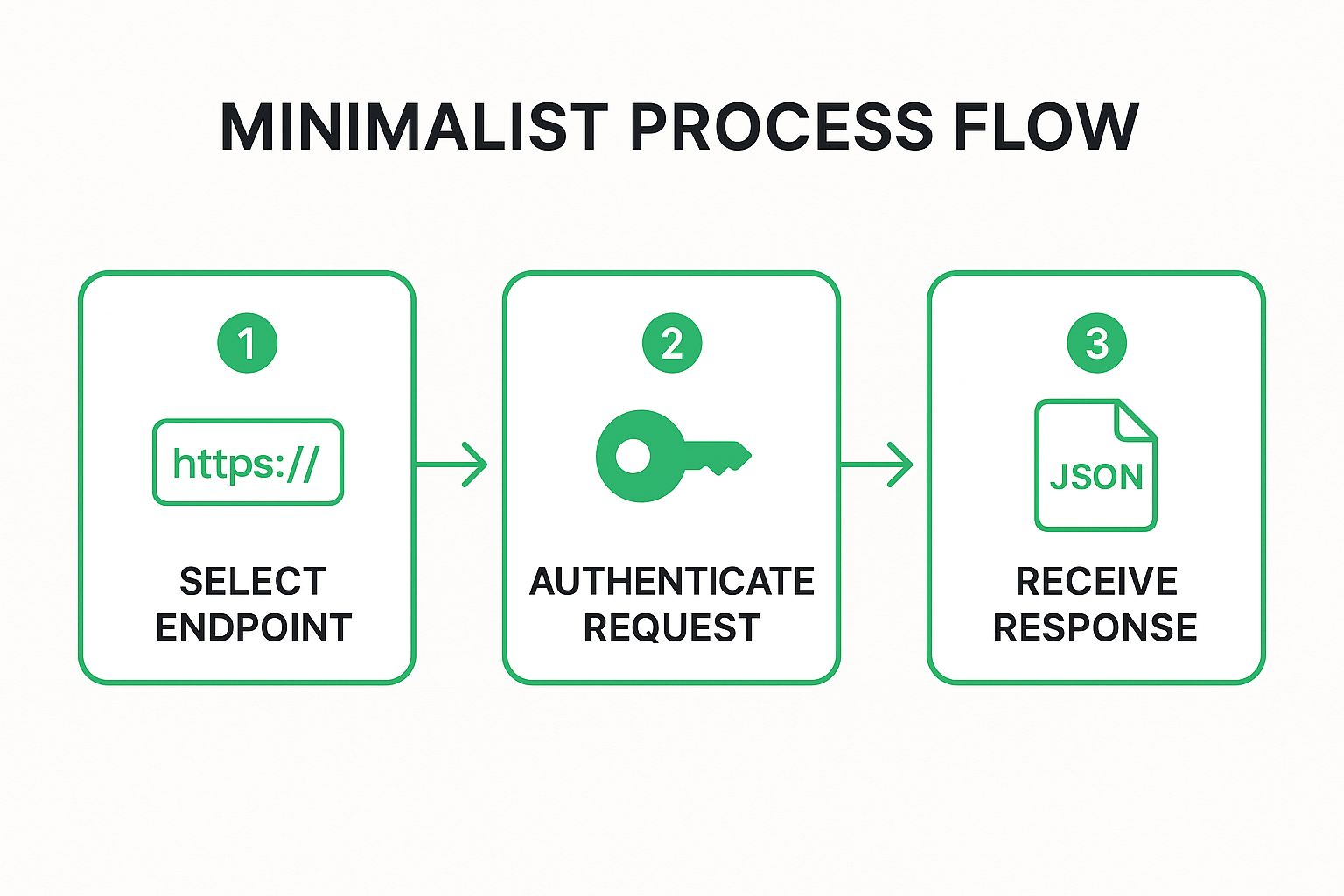Discover the top example of technical documentation in our 2025 guide. Learn from API docs, user manuals, and architecture guides to improve your own docs.
Technical documentation is the backbone of any successful software product, yet it’s often misunderstood as a mere instructional manual. It’s a critical strategic asset: a powerful tool for user adoption, developer efficiency, and system scalability. The difference between adequate and exceptional documentation lies not just in what is written, but in its structure, clarity, and intentional design. A well-crafted example of technical documentation can dramatically reduce support tickets, slash onboarding time for new developers, and cultivate a community of empowered, loyal users.
In this comprehensive guide, we move beyond abstract theory to dissect seven distinct types of technical documentation. We will analyze real-world examples from industry leaders to uncover the specific strategies that make them so effective. This isn’t just a showcase; it’s a strategic breakdown. For each example, we will pinpoint the tactics used, from crafting an intuitive API reference to designing a system architecture guide that enables seamless collaboration.
You will learn to identify and replicate the key elements that transform documentation from a simple necessity into a competitive advantage. Prepare to gain actionable insights you can immediately apply to your own projects, whether you’re documenting a complex API, a new software application, or an entire system.
Need to create clear, effective technical documentation? DocuWriter.ai uses AI to help you build comprehensive user manuals, API guides, and more, faster than ever.
API reference documentation is the essential instruction manual for developers who need to interact with a software application programmatically. This type of technical documentation outlines every available endpoint, the required parameters, authentication methods, and the structure of expected responses. It serves as the primary, authoritative resource for integrating a service, making it one of the most critical examples of technical documentation for any company with a public or internal API.
For developers, clear API documentation is not just a convenience; it is a critical factor when they are finding and evaluating the best API for a specific business need. Poorly documented APIs create friction, increase development time, and can lead to incorrect implementation, whereas excellent documentation accelerates adoption and fosters a positive developer experience.
Companies like Stripe and Twilio have set the industry standard, demonstrating that API documentation is a core product feature. Their success lies in a three-column layout that presents conceptual explanations, code samples, and an interactive request/response viewer simultaneously. This design allows developers to read, code, and test in a single, unified interface.
This approach transforms static documentation into an interactive development environment. GitHub’s API documentation excels by providing deep links to specific API versions and clear changelogs, ensuring developers can manage integrations across different releases without ambiguity.
To create effective API reference documentation, focus on developer efficiency and clarity. Here are specific tactics to implement:
The following infographic illustrates the fundamental process flow a developer follows when interacting with a REST API endpoint, a core journey that your documentation must simplify.

This streamlined, three-step interaction highlights the importance of clear guidance on endpoint selection, authentication, and response handling in your documentation to ensure a seamless developer experience.
DocuWriter.ai helps you create clear, comprehensive, and developer-friendly documentation with AI-powered tools. Streamline your API reference creation and deliver an exceptional developer experience today.
Software Development Kit (SDK) documentation is a comprehensive guide for developers using a specific set of tools, libraries, and code samples to build applications for a particular platform or service. Unlike API documentation, which focuses on endpoint interactions, SDK documentation provides the entire toolkit, including code libraries, debugging tools, and sample applications. It serves as the foundational instruction manual for creating software within a specific ecosystem, such as Android, iOS, or AWS.
For engineering teams, well-structured SDK documentation is a critical accelerator. It reduces the learning curve, simplifies complex integrations, and ensures that developers adhere to platform-specific best practices. Clear guidance on installation, configuration, and class/method usage directly impacts development speed and application quality, making it an essential example of technical documentation for any company distributing a development kit.
Companies like Google (for Android) and Apple (for iOS) have set the standard for SDK documentation by integrating it deeply into their development environments (IDEs). Their documentation is not just a static website; it is a dynamic resource accessible directly within Android Studio or Xcode. This contextual access provides developers with instant information on classes, methods, and implementation patterns without disrupting their workflow.
This approach transforms the documentation from a simple reference into an active development partner. Amazon’s AWS SDK documentation excels by offering guides tailored to specific use cases and services, allowing developers to quickly find a path to implementing complex cloud architectures. This problem-oriented structure is far more effective than a simple library reference.
To create effective SDK documentation, focus on a smooth onboarding process and providing practical, real-world context. Here are specific tactics to implement:
DocuWriter.ai helps you create clear, comprehensive, and developer-friendly documentation with AI-powered tools. Streamline your SDK documentation and deliver an exceptional developer experience today.
A user manual is a quintessential example of technical documentation designed to guide end-users in effectively operating a software application. This documentation translates complex features and functionalities into understandable, step-by-step instructions. It serves as a comprehensive reference that empowers users to complete tasks, troubleshoot common issues, and maximize the value they get from the software, directly impacting user adoption and satisfaction.
For non-technical users, a well-structured manual is the primary bridge between their goals and the software’s capabilities. A confusing or incomplete manual leads to frustration, an increase in support tickets, and potential customer churn. In contrast, clear, accessible documentation fosters user independence, builds confidence, and enhances the overall user experience, turning a functional product into a usable one.
Companies like Adobe and Microsoft have long established the standard for comprehensive user manuals that cater to a wide range of user skill levels. Salesforce excels by structuring its documentation around user roles and specific business goals, making its complex CRM system navigable. Their success hinges on a user-centric approach that organizes information intuitively, often using a combination of task-based guides, feature explanations, and a searchable knowledge base.
This strategy shifts the focus from a simple feature list to a problem-solving resource. Slack’s Help Center is a modern example, blending traditional manual entries with short, digestible articles and FAQs that address specific user questions. This makes the documentation feel less like a dense textbook and more like an interactive, on-demand support system.
To build an effective user manual, prioritize accessibility and task-oriented guidance. Here are specific tactics to implement:
DocuWriter.ai helps you create clear, comprehensive, and user-friendly documentation with AI-powered tools. Streamline your user manual creation and deliver an exceptional customer experience today.
System architecture documentation provides a high-level, comprehensive overview of a system’s design. This type of technical documentation serves as a blueprint, detailing component relationships, data flows, and infrastructure requirements. It is an essential resource for developers, system administrators, and stakeholders to understand how a complex system is structured and how its parts interconnect to achieve business goals.
For engineering teams, clear architecture documentation is foundational for scalability, maintenance, and onboarding. It aligns teams around a common technical vision, preventing architectural drift and ensuring that new features are developed in a way that is consistent with the system’s core design principles. This makes it a crucial example of technical documentation for any organization building or maintaining a complex software product.

Organizations like Netflix and Amazon Web Services (AWS) have pioneered modern approaches to system architecture documentation. Netflix’s extensive public documentation on its microservices architecture provides a masterclass in explaining complex, distributed systems. Similarly, the AWS Well-Architected Framework offers prescriptive guidance and design patterns that have become an industry standard for building reliable and scalable cloud infrastructure.
This strategic approach ensures the documentation remains relevant and useful. For instance, Simon Brown’s C4 model popularizes creating contextual, container, component, and code-level diagrams, allowing viewers to zoom in or out of the architecture as needed. This tiered approach prevents information overload while providing necessary depth.
To create effective system architecture documentation, focus on clarity, context, and maintainability. Here are specific tactics to implement:
The following diagram illustrates the fundamental levels of detail in the C4 model, a core concept your documentation can adopt to serve different audiences effectively.
This hierarchical structure highlights the importance of providing tailored views of your system, ensuring that every stakeholder, from project managers to individual developers, can find the information they need without unnecessary complexity.
DocuWriter.ai helps you create clear, comprehensive, and developer-friendly documentation with AI-powered tools. Streamline your system architecture documentation and align your teams today.
An installation and configuration guide is a foundational piece of technical documentation that provides step-by-step instructions for setting up software, hardware, or an entire system. This document is often the first interaction a user has with a product, and its clarity directly impacts their success and initial perception. It covers everything from system prerequisites and installation procedures to initial configuration settings, ensuring a user can get the product running correctly in a specific environment.
For system administrators, DevOps engineers, and developers, a well-crafted installation guide is indispensable. It mitigates the risk of failed deployments, reduces support ticket volume, and empowers users to self-serve. This type of documentation is a prime example of technical documentation where precision, clarity, and thoroughness are non-negotiable, as a single missed step can lead to a completely non-functional system.
Companies like Docker and Red Hat have set high standards for installation guides by recognizing that a successful setup is the gateway to user adoption. Their guides are not just a list of commands; they are structured learning paths that cater to different operating systems and user expertise levels. Docker’s documentation, for instance, provides distinct, easy-to-follow instructions for macOS, Windows, and various Linux distributions, complete with one-click copyable scripts.
This strategy shifts the focus from merely documenting steps to architecting a successful onboarding experience. Atlassian’s guides for products like Jira and Confluence excel by including verification steps and troubleshooting sections after major installation stages, allowing users to confirm success and resolve common issues before moving on.
To create an effective installation and configuration guide, prioritize user success and anticipate potential points of failure. Here are specific tactics to implement:
docker --version to confirm the installation.”DocuWriter.ai helps you create clear, comprehensive, and user-friendly documentation with AI-powered tools. Build installation guides that ensure user success and reduce support overhead today.
Troubleshooting guides and FAQ documentation are reactive, problem-solving resources designed to help users diagnose and resolve common issues independently. This type of technical documentation anticipates user challenges, providing systematic, step-by-step solutions to errors, operational difficulties, and frequently asked questions. It is a critical example of technical documentation that directly impacts user satisfaction and reduces the burden on customer support teams by empowering users to self-serve.
Effective troubleshooting content is organized for rapid problem identification, moving from symptom to solution with minimal friction. For complex enterprise software or hardware, this documentation is indispensable for maintaining system stability and user productivity, acting as the first line of defense against operational disruptions.

Leaders in this space, such as Microsoft, Atlassian, and VMware, have built extensive knowledge bases that serve as centralized hubs for problem resolution. Their success stems from a highly structured, searchable format that organizes content by product, feature, and specific error codes. Atlassian’s Confluence-based knowledge base, for example, integrates tightly with its Jira Service Management tool, allowing support tickets to be converted directly into new troubleshooting articles.
This strategy creates a powerful feedback loop where real-world user problems continuously enrich the documentation. Stack Overflow popularized a community-driven model where the best, most-voted-on answers rise to the top, providing a crowdsourced validation of effective solutions.
This approach transforms customer support from a cost center into a content generation engine. By analyzing support ticket data and search queries within the knowledge base, companies can identify documentation gaps and proactively address emerging issues before they become widespread problems.
To build effective troubleshooting and FAQ documentation, focus on discoverability and clarity. The user is often frustrated when they arrive, so the experience must be seamless.
DocuWriter.ai helps you create clear, comprehensive, and developer-friendly documentation with AI-powered tools. Streamline your API reference creation and deliver an exceptional developer experience today.
Code documentation is the practice of embedding explanations directly within or alongside a software’s source code. This type of technical documentation includes comments, function-level docstrings, and module headers that explain the purpose, logic, and usage of the code. It is the most granular form of documentation, intended for developers who are actively working on, maintaining, or debugging the codebase.
For developers, high-quality code documentation is indispensable. It accelerates the onboarding process for new team members, simplifies code reviews, and is crucial for the long-term sustainability of any software project. Unlike other forms of documentation that describe a system from the outside, code comments provide context from the inside, explaining the “why” behind specific implementation choices. This makes it a foundational example of technical documentation in software engineering.
Programming languages like Python (with its PEP 257 docstrings) and Java (with JavaDoc) have institutionalized code documentation by creating standardized formats and tooling. This standardization allows for the automatic generation of comprehensive documentation websites directly from the source code, as famously demonstrated by tools like Sphinx for Python and the Rust language’s built-in cargo doc command.
The Rust programming language takes this a step further by integrating documentation directly into its testing framework. This encourages developers to write documentation that is not only descriptive but also verifiable through runnable code examples, ensuring the documentation never becomes outdated or incorrect.
This approach transforms the codebase itself into the primary source of truth. A well-documented file, like a GitHub README, can effectively serve as the entry point for an entire project, guiding contributors on setup, usage, and contribution policies, thereby lowering the barrier to entry for community involvement.